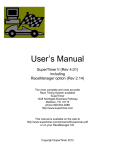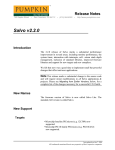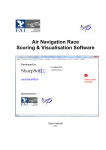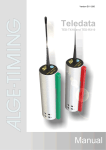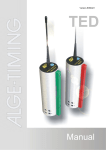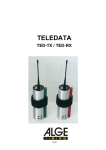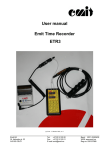Download indicates number for 6 lane tracks
Transcript
SuperTrack Installation Instructions www.supertimer.com 1-800-654-2088 SuperTrack Parts List [indicates number for 6 lane tracks] 1 Track Instruction Manual (this booklet) 2 Start sections [3] Start Gate Note the latch peg attached to rotating bar for shipping. Blue Foam Garage 2 Shock Cords Flag Pack Hardware Pack (Yellow cords, blue cord locks, Rubber bands, flag grommets, hardware) Start Stand (dimensions approximate) 2 Top Vertical Supports, 3’ long with 45° fitting 4 Mid Vertical Supports, 1.5’ long plain 2 Low Vertical Supports, 3.5’ long with ‘T’ fitting 3 Flag Horizontal Supports, 1.5’ long with two ‘T’ fittings) [2'] 1 Plain Horizontal Support, 1.5’ long with two 90° fittings [2'] 1 Weighted Support Base, 3.5’ long with 8 ‘T’s and two end caps 1 Plain joiner, 7.5” long [2] 1 Joiner with blue feet, 7.5” long [2] 2 Finish Sections [3] Middle Sections by Model: 435 – 6; 442 – 8; 449 - 10; 635 - 9; 642 - 12; 649 - 15; SuperTimer II Parts when provided with SuperTrack 1 SuperTimer II User’s Manual (Yellow cover booklet) 1 SuperTimer II electronic assembly 1 Speaker box with two speakers 1 Finish assembly (circuit board with four [6] finish sensors) 1 50’ RJ-11 silver cable (timer to start gate board) 1 7’ RJ-45 silver WIDE cable (timer to finish line board) 1 Power Supply RaceManager Software Option 1 CD 1 50’ RJ-11 to DB-9 black cable (timer to computer serial port) Page - 1 - of 8 “Welcome to SuperTimer II and SuperTrack.” These written instructions mostly mirror the SuperTrack Installation Video which is available for download in the SuperTrack Tech Support Section at http://www.supertimer.com/pinewood/tech_track.html The video was also provided with SuperTrack, usually as part of the SuperTimer II RaceManager CD. Open the boxes, (you've already done this and found these instructions inside the top box section), remove the Start sections and accessories (they're wrapped together), then cut the shrink wrap to release the Lane 1-2 Start section. Put that section aside, and release all the other components including the Start Gate Assembly. “Tracks without SuperTimer II will not have the Solenoid Board on the left.” In fact manual starting gates will be latched in a similar fashion but from the other side of the rotating blue bar. In either case, put the Starting Gate Assembly aside for the moment. “Arrange the starting ramp pieces before assembly.” This checks to be sure you have all the pieces properly identified and makes assembly somewhat more obvious. The weighted base at the top of the picture (with the 8 ‘T’ fittings) will be directly below the starting gate. The bottom of the picture will be near the bottom of the ramp. Note the position of the PVC fittings on the base and on the long rods, be sure they aren't pointing the other way. “Be sure the outside short blue tip faces forward.” Insert the vertical supports as shown taking special care that they are fully inserted and facing as shown. “And, Be sure the inside short blue tip faces up.” Of course, you'll need to repeat these operations on the other side of the weighted base so that all eight vertical supports are installed. “Connect the four horizontal supports as shown.” Note that the horizontal support without the 'T's on the ends is used in the lower middle position. It's perfectly normal for the vertical supports to be bent to accommodate the horizontal supports. In fact, it strengthens the assembly. “Be sure ALL joints are FULLY inserted.” Page - 2 - of 8 1. “Slide the hooks to the end of each shock cord and attach them at the top and bottom.” The shock cords are adjustable but should be adjusted to their maximum length. It's not essential, but it will look nicer if the body of the hooks is toward the inside of the track. The stand will now look very strange. it's okay. 2. “Look on the back of the Lane 1-2 Start section.” “Place the Blue foot on the lower horizontal support.” If the Start section slides off, the Blue foot is on the wrong side of the horizontal support. 3. “Load the 'bow and arrow' till the Blue foot latches.” Put your foot on the weighted base, pull the upper horizontal support toward you while you push the Start section down. The Blue foot will be in front of the upper horizontal support, the shock cords will be stretched and the stand will be essentially flat on the ground. It will be more flat when all Start sections have been added. 4. “Add other Start sections.” After the Blue feet have been 'latched', be sure the edges of the sections line up. One edge is an “E”, the other an inverse “E”. 4 Lane tracks have two start sections, 6 Lane tracks have three start sections. They may be Yellow or Blue. Lane 1 is always on the right looking down the track. 5. “Slide the starting gate down to the top horizontal support.” The “T”s on the underside of the Starting Gate line up just outside of the “T”s in the middle of Lanes 2 and 3 (and 4 and 5 on 6 Lane tracks). Because of the large rectangular slots for the lane pegs, you'll need to restart the “T”s when the Starting Gate gets close to the top horizontal support. 6. “Insert the Latch Peg sharp edge toward the track, then latch the Gate.” Push the round part of the peg in only as far as the small bump on the peg. (The same is true for the lane pegs and damper peg.) For a detailed discussion of the Start Gate operation see http://www.supertimer.com/track/startgate.html Page - 3 - of 8 7. “Place the loop of the yellow cord over the top horizontal support.” 8. “Thread the other end as shown.” Use the blue cord locks in the hardware pack. If two locks are together, bend them back and forth to separate. 9. “Then Attach it to the diagonally opposite base end and tighten”. Loop the cord lock loop around the base end and pull the cord lock to tighten. 10. “Add the second cord and tighten both so that the section joint is even.” If one section is higher than the other, tighten the cord whose loop is on the high side. This will square up the starting ramp and make it quite stiff. 11.“Install the plain joiner at the bottom of the ramp.” This installs just like the Starting Gate at the top of the ramp only easier. It should stick out to act as a splice for the extensions which will be added. It is used here because the splice is up in the air and still curving slightly. It is not used on the other splices. 12. “Pick an extension and locate the end with the extra tabs.” “Tape rubber bands into the 'T' slots on that end only.” If you have a helper, they can do this to all extensions at this time. You can leave the rubber bands in place when you disassemble SuperTrack to make installation easier next time. Page - 4 - of 8 13. “Slide the extension in place (temporarily) and attach the rubber bands.” In this case the rubber bands will attach to the blue foot at the bottom of the ramp. Additional extensions will have their rubber bands attached to slots in the previous section. 14. “Then align the tabs.” Don’t worry about perfect alignment until SuperTrack is completely assembled as things will move during assembly. 15. For adjacent sections, “Align the edge, then the 'T', then repeat.” 16. “Put the garage under the far end of the extensions.” “Place a prepared extension on top of the previous extension.” “Use Your Thumb and Middle finger to stretch the band and your Index finger to find the slot and place the rubber band.” Connect each lane’s rubber band to the slot on the same lane of the previous section. 17. “Pull the sections apart and latch into place.” “Repeat adding sections until the end of the track.” 18. “Lift the finish, place the garage on edge underneath.” Connect one end of the WIDE silver RJ-45 cord to the finish line board. “Slide the finish board in the 'T' slots toward the finish line.” Use the ‘T’ slots under lanes 3 and 4 on six lane tracks. “Push the sensors (numbered on board) thru the track holes.” At this point just get the sensors up and out of the way. You may want to use a ‘magic marker’ to write the lane numbers on the sensor blocks for future assembly ease. Page - 5 - of 8 19. “Slide the joiner with feet just past the end slots.” Again it connects just like the Start Gate and the joiner at the bottom of the ramp. This joiner mostly provides a little room at the end of SuperTrack for the wiring. 20. “Remove the garage, snap the sensors into place.” Be sure the pointed end points at the starting gate. 21. “Insert a screw thru the 2nd hole from each edge (4th hole on six lane tracks).” “Spin the wing nut down and tighten it firmly.” These screws absorb the energy from the cars entering the garage. It’s best if the wing nut is very tight. 22. “Remove the plugs from garage and place the garage over the screws.” If you DON’T have SuperTimer II, drop a flat washer on the garage and spin the remaining nut down to hold it generally in place. This nut need not be tight. And, you can skip to ‘Installing the Flags’ below. If you have SuperTimer II, it’s time to start wiring. 23. Following the labels on the underside of SuperTimer II, “Plug in the speakers. A Jack is available for your amplifier.” “Plug in the Finish Line wire. (WIDE Silver RJ45)” “Plug in the starting gate wire. (Silver RJ-11)” “If you have RaceManager, plug in the computer wire. (Black RJ-11)” “Push all wires into the large holes in the garage.” 24. “Mount SuperTimer II using the flat nuts.” The nuts need only be flush with the ends of the screws, not tight. You may wish to postpone this step until you’ve tested everything. Page - 6 - of 8 25. “Wrap the starting gate wire around the yellow cords and connect it to the solenoid board.” “Repeat for the power supply wire and plug it into wall power.” This provides strain relief preventing the connectors from being pulled out of the board. 26. ”Connect SuperTimer II to your Serial Port directly.” “Or indirectly using the USB/Serial Converter.” 27. “Install flags at the starting gate and on the garage.” Reverse roll the flags so they ‘fly’ flat. Use the rubber grommets from the hardware pack to support the flags in the ‘T’s on the starting stand. Using a spare flag stick, gently push the grommets down to make the flag vertical. 28. Time to Race! (or at least test.) Page - 7 - of 8 Additional Hints 1. “For 'fancy' cars, use a plug temporarily.” Leave the plug out about an inch so the car is slowed driving the plug home. Since the cars don’t go fully into the garage, it’s a good idea to test any one you suspect may have a problem. It’s a better idea to test ALL cars at registration to be sure they make it to the end of the track. Fixing a car before racing starts is a lot less controversial. 2. When the race is over, “To remove the sensors, push them up from under the track.” Then, just feed them back thru SuperTrack and slide the finish line board out. 3. ”Store the sensor assembly inside SuperTimer II.” Put one group of sensors in one end, fold the wire so that the circuit board is in the middle, put the other group of sensors at the other end again folding the wire. Be sure no sensor tab is permanently bent. “Disconnect the rubber bands by sliding an extension under the track.” Starting from the finish line, pull the extension joint apart and then slide the downstream extension under the upstream extension. The two will disconnect automatically. Leave the rubber bands in place for next time. Store the extensions back/back then front/front in the blue box. Protect the Starting Gate from having the weighted base slide into it during transport. Page - 8 - of 8








